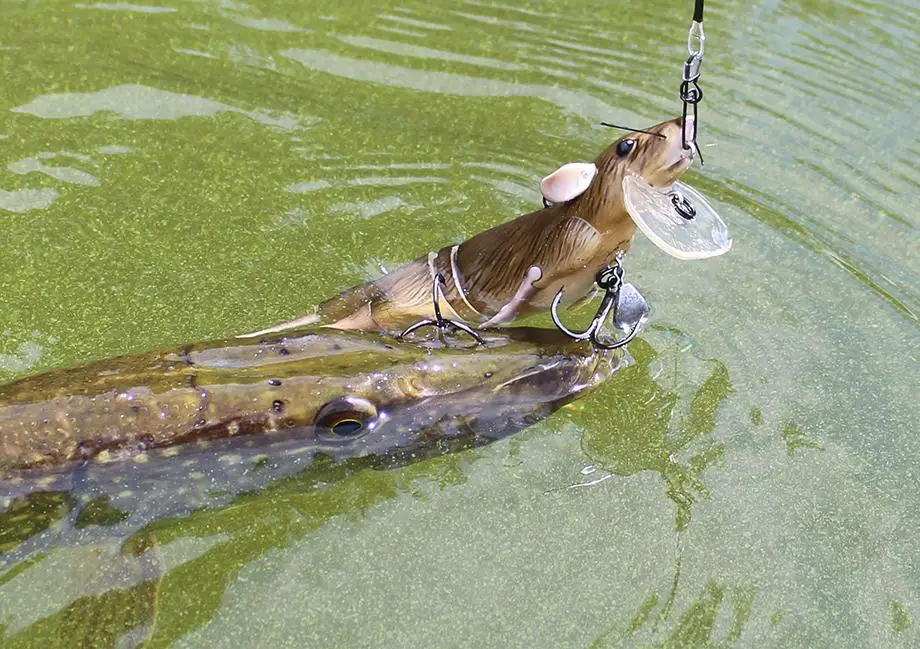Predator anglers are always on the lookout for effective lures that can entice ferocious pike, the deadliest freshwater fish. Among the more unconventional options, rat lures have gained popularity in recent years. But do these faux rodents truly have a place in the tackle box, or are they just a gimmick? This topic is the next one in my series of lures for pike articles. So join me as we delve deep into the world of rat lures for pike, exploring their effectiveness, benefits, and tips for use.
What Are Rat Lures?
Rat lures resemble real rodents, often mimicking the appearance of baby rats or mice that may inadvertently fall into the water. Manufacturers craft these surface lures from soft plastic or rubber and equip them with hooks, sometimes adding feathered treble hooks to enhance their appeal. Their realistic designs often feature details like a tail, whiskers, and lifelike colors to attract the attention of wary predator fish.
What Materials Do Manufacturers Use To Make Rat Lures For Pike?
The materials used in the construction of these lures play a critical role in their performance and durability.
High-Quality ABS Plastic
Most rat lures, including popular models like the Spro BBZ-1 Rat, have high-quality ABS plastic bodies crafted from ABS (Acrylonitrile Butadiene Styrene) plastic. This material is favored for its strength and resilience, allowing the lure to withstand the wear and tear of fishing environments. ABS plastic is resistant to impact, ensuring that the lure maintains its shape and functionality even after repeated use.
Realistic 3D Scanned Details
One of the standout features of rat lures is their realistic appearance, achieved through advanced 3D scanning technology. This process captures the intricate details of a rat’s body, from its fur texture to its eyes, resulting in a lifelike imitation that can fool even the most cautious, biggest pike.
Carbon Steel Hooks
Rat lures feature high-strength carbon steel hooks that enhance their performance for hooking and landing fish. Carbon steel hook action is known for its sharpness and durability, ensuring that the hooks can penetrate effectively while resisting bending or breaking during use. This feature is crucial for anglers targeting larger fish.
Reinforced Tail
The tail of the rat lure is another important component, often reinforced to provide a consistent swimming action. The lure’s design mimics the natural movement of a swimming rat, creating a subtle wake on the surface or a diving action, depending on how the angler retrieves it. The reinforced tail enhances the lure’s durability, ensuring that it maintains its intended action even after repeated encounters with fish.
Comparing Rat Lures for Pike to Traditional Lures
When it comes to pike fishing, anglers are often faced with a pivotal choice: to opt for innovative designs that resemble small animals, such as surface frog lures or rat lures, or stick with the tried-and-true traditional lures. Both types have unique attributes, but understanding their differences can significantly affect your fishing success.
Design
Rat lures, like the Savage Gear 3D Rat feature realistic details, including textured bodies and lifelike swimming actions, intended to provoke instinctual predatory responses from fish. In contrast, traditional lures—whether they are spoons, spinners, or crankbaits—often rely on colorful body and flashy designs to attract attention. While effective, they may not evoke the same predatory instinct that a rat lure can.

The image is courtesy of Savage Gear.
Action and Retrieval Techniques
Rat lures are primarily topwater lures, which create a disturbance on water surfaces that can generate excitement among pike. The way these lures are retrieved can mimic the movements of the rat swimming towards the shore, making them particularly alluring. Traditional lures offer a broader range of action styles; for example, crankbaits dive underwater to create vibrations and flashes that can get the attention of fish from a distance. This versatility allows anglers to adapt their techniques based on water conditions and pike behavior.
Fishing Conditions and Environments
Rat lures excel in shallow waters and areas with heavy vegetation, where pike often ambush their prey. Their surface action can be particularly effective in these environments, drawing attention from lurking pike. Conversely, traditional lures may perform better in deeper water or when pike are less inclined to chase prey on the surface. The choice between the two can ultimately depend on the specific fishing conditions and the time of year.
Anecdotal Evidence and Success Stories
In recent years, the use of rat lures in pike fishing has gained significant traction among anglers, leading to numerous anecdotal success stories that highlight their effectiveness.
Here are some of them.
John Keane, a seasoned angler and a well-known member of the fly fishing community shared his experience using the Savage Gear 3D Rat Surface Lure while fishing in a canal renowned for its pike population. Although he didn’t hook a pike during his outing, the lure’s action captivated him, demonstrating how effectively it could attract attention—even from other wildlife like ducks and coots. This excitement around the visual appeal of the lure suggests that it can create a compelling presentation in the water, potentially leading to successful catches on future trips.
Other anglers have echoed similar sentiments, citing instances where they had fantastic days on the water using rat lures. They report that pike, known for their aggressive predatory nature, are drawn to these lures because they simulate easy targets. For example, one angler fishing a stretch of the River Stour recounted using a rat lure and finding that pike were more likely to strike than with traditional lures. This anecdote emphasizes how the innovative design of rat lures can lead to a higher success rate when targeting pike.
Furthermore, the success stories extend beyond just individual experiences. Fishing forums are abuzz with discussions about these lures, with many anglers sharing photos of their impressive catches. The combination of realistic design, innovative swimming action, and the element of surprise seems to resonate with the pike, leading to increased interest and strikes.
Conclusion
As the popularity of rat lures grows within the fishing community, it’s clear that they have carved out a niche for themselves in the world of predator fishing. These anecdotes and success stories not only bolster their credibility but also encourage anglers to experiment with rat lures in their own fishing endeavors, contributing to the ongoing exploration and enjoyment of pike fishing.
